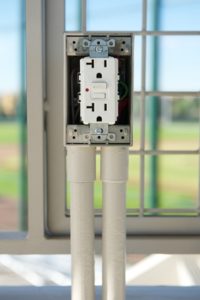 GFCI protection is a required safety measure for virtually all outlets close to water or in outdoor areas. The term stands for ground fault circuit interrupter, meaning it can detect an electrical fault (incorrect energy flow) and shut off power before an accident or injury occurs.
GFCI protection is a required safety measure for virtually all outlets close to water or in outdoor areas. The term stands for ground fault circuit interrupter, meaning it can detect an electrical fault (incorrect energy flow) and shut off power before an accident or injury occurs.
You can install a GFCI receptacle installed at an individual power outlet, or you can use a GFCI breaker in the electrical panel to have GFCI protection for all outlets powered by that breaker.
The choice between a GFCI breaker or a GFCI receptacle depends on your home’s electrical wiring, location of outlets that need protection, space available, and costs.
GFCI Receptacle vs. GFCI Breaker
The GFCI receptacle sits right inside an individual power outlet. You know those power outlets with the test and reset buttons? That’s the face plate of a GFCI receptacle. The receptacle itself is the electrical unit inside the wall. GFCI receptacles are a bit larger than standard receptacles.
Anything plugged into a GFCI receptacle will shut off if the unit detects a problem. If there are power outlets connected further down the same line, those outlets will also lose power in case of a problem.
The GFCI breaker is built into (or added onto) your electrical panel. Instead of the basic breaker switch that flips on and off, the GFCI breaker is typically a little larger and has its own test and reset buttons.
Every power outlet that operates on the GFCI breaker’s line will have full GFCI protection.
When Should I Use a GFCI Receptacle?
GFCI receptacles work perfectly well for many applications:
- When a circuit powers some receptacles that need GFCI protection and some that don’t
- When the receptacle is located far away from the panel box
- When you need few GFCI outlets and don’t want the expense of a high-quality GFCI breaker
When Should I Use a GFCI Breaker?
Protecting an entire circuit with a GFCI breaker can also make sense:
- When most or all outlets on a circuit need GFCI protection
- When some outlet locations lack the space for bulky GFCI receptacles
- If you simply prefer the greater protection of the entire circuit
- For specialty uses that require a GFCI breaker, such as heated swimming pools
Operating a GFCI Breaker or Receptacle
You can use all your appliances and electronics normally with GFCI lines. The power simply shuts off when the GFCI detects an abnormal current — for example, if a blow dryer gets wet.
Monthly GFCI tests help ensure that the system can successfully detect a problem. Simply plug in an appliance, turn it on, and press the test button. The power should shut off and then you can press the reset button. To test a GFCI breaker, you can test every outlet connected to the circuit.
Installing GFCI Devices
A new GFCI breaker or receptacle is a relatively simple electrical project, but it still requires plenty of knowledge about electrical wiring and safety practices. Installed improperly, a GFCI device could fail to provide real protection and may result in significant or even fatal injury.
Want the best performance and protection? Don’t want to buy special tools or spend your free time tinkering with dangerous wiring? Hire a residential electrician to install your GFCI devices professionally!

